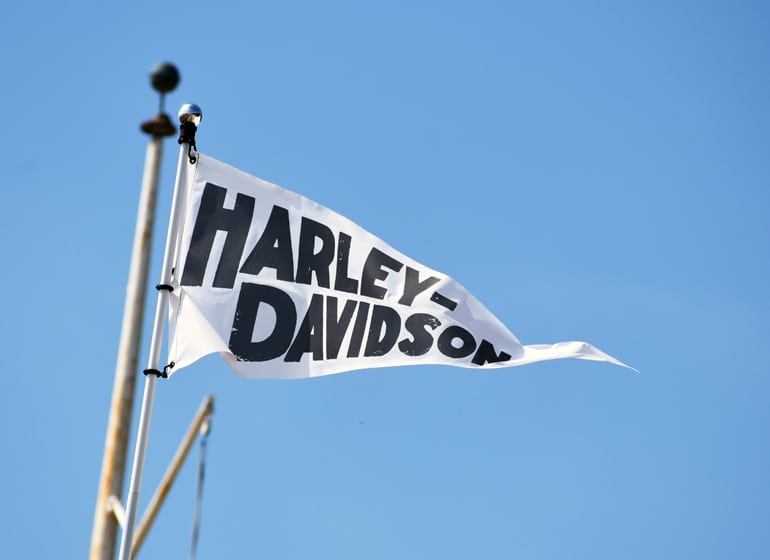Harley-Davidson Inc. saw U.S. retail sales continue to decline in the third quarter and the company is facing up to $112 million in additional tariff costs next year, but company executives said Tuesday they expect to offset the increased costs and argued their efforts to boost the U.S. motorcycle market are working.

“The unbelievable resilience of Harley-Davidson, it never ceases to surprise me,” said John Olin, Harley chief financial officer.
Olin pointed to Harley’s third quarter results, which included a 16.8 percent increase in motorcycle-related revenue with higher shipments and a more favorable mix of products, even as U.S. retail sales declined 13.3 percent in the quarter.
For the year, shipments are down 4.7 percent worldwide, but revenue is up 3.7 percent. Net income is up 3.4 percent for the year and was up 67 percent in the quarter.
Olin said the company was also encouraged by a fifth straight quarter of improving used motorcycle prices, but said he expects the U.S. market to remain challenging into 2019.
The other major challenge facing Harley next year is how to address $90 million to $100 million in European tariffs on heavyweight motorcycles and $10 million to $12 million in increased costs from the ongoing trade dispute between the U.S. and China.
“We expect to offset the vast majority of it,” Olin said, although he did not get into specifics of how the company would mitigate the increased costs.
He added that increased steel and aluminum prices from tariffs cost the company $15 million to $20 million this year, but the company expects prices will remain at higher levels moving forward.
After the European Union announced tariffs earlier this year on motorcycles and other U.S. products in response to the steel and aluminum tariffs, Harley said it would shift production of its bikes for Europe to overseas facilities. The company has operations in Brazil, India and Thailand.
Olin said the company is still evaluating how to relocate the production of almost 40,000 motorcycles annually, including logistics and supply chain considerations.
“This is something we never contemplated doing,” he said, adding an announcement about where the production will move is likely coming in the “first part” of 2019.
Harley is also pursuing other avenues to avoid tariffs, including lobbying for exemptions with the U.S. government, Olin said.
Even before tariffs, Harley was facing a challenging environment. Aging baby boomers have left motorcycling, reducing demand for new bikes and leaving more used bikes on the market. Domestic competition has also increased with the revival of Indian Motorcycle by Polaris Industries.
Last year, Harley unveiled a 10-year strategy to help boost the number of riders in the U.S., grow its international business and enter new product categories. This year, the company announced a five-year plan to accelerate that strategy, highlighted by the introduction of an electric motorcycle next August.
Matt Levatich, Harley president and chief executive officer, said the company’s interactions with stakeholders are often met with a skepticism that Harley isn’t doing enough to attract new riders, doesn’t have the right products or is losing market share.
“The data just doesn’t support those kind of simplistic conclusions,” Levatich said.
He pointed out nine of the 13 models in the company’s new Softail platform are selling to younger riders than the previous Softail and Dyna models that were combined to create the platform.
Levatich also said Harley’s social media intern program, which gave eight interns a Harley-Davidson motorcycle and an opportunity to ride around the country, generated 200 million media impressions and 43 million social video views. While those metrics are important, he said the program also gave the company insights into how young people interact with the brand.
“We were able to really see through their eyes how to focus our efforts,” he said.
Harley’s market share did decline in the quarter – from 53.1 percent last year to 50.9 percent this year – and year-to-date it is down 1 percentage point to 49.7 percent. Levatich and Olin both argued the loss is due to growth in segments the company currently does not compete in, and that market share is growing where Harley does have product offerings.
“We know the biggest challenge isn’t relative competitiveness, but the ongoing overall decline in the U.S. industry,” Levatich said.
He also emphasized the three main elements of the company’s five-year strategy — adding new products, increasing access and strengthening its dealer network — are all interconnected. He said Harley’s storefront on Amazon will help expose the brand to new potential customers, while targeting people living in urban areas means piloting new dealership models to meet people where they are.


